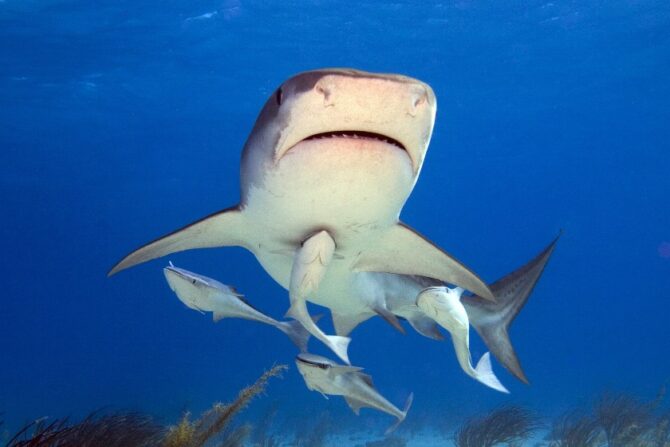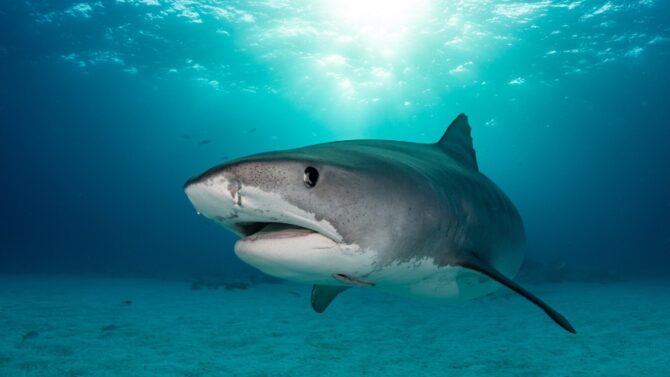The question what do sharks eat perhaps might have been inspired by movies that portray these sea creatures as relentless, ferocious hunters and merciless marine carnivores.
In fact that 96% of movies on IMDB paint these creatures as oppressive threats with an unquenchable hunger.
While scientists believe these movies exaggerate sharks’ feeding patterns and diet choices, it leaves us with concerns about what they eat and how their diet affects the food chain.
Without further ado, let us consider what sharks eat, how they hunt their prey, how much food they eat, and other facts about their diet.
A Closer Look At Shark Diet & Food Chain
Scientists have discovered about 500 extant shark species, revealing the diversity of one of the ocean’s most captivating creatures.
Thus, accounting for each species’ food habits will be challenging and undoubtedly voluminous, thanks to the variance of their individual food choices.
Sharks may take nonfatal lumps of flesh from their prey or devour large marine animals in a few gulps. Still, it is possible to have a broad idea of sharks’ diets and nutritional demands.
While many shark species are exclusively predatory, some supplement their diet with non-meat food sources like plankton. These ferocious fishes are well adapted for hunting with large mouths full of several rows of razor-sharp teeth.
However, sharks facilitate population control in their ecosystems by using effective hunting strategies to target weaker, immature, or sickly animals.
Sharks have a large appetite for a widely carnivorous clan, earning a widespread reputation as the “garbage cans of the sea.” Still, the question lingers, “What do sharks eat?”
What Do Sharks Eat?

While sharks are a diverse group of animals, they tend to have one of just two primary diet types.
All sharks are carnivorous, feeding on marine animals like fish, seals, and turtles, while some supplement their diet with tiny plankton species of algae and drifting or floating marine animals.
Many shark species are apex predators, with no formidable food competitor, which places them at the top of their food chain. However, not all sharks are vicious, predatory opportunists. Examples are basking and whale sharks that filter feed on plankton and other species.
As stated earlier, listing the food choices for each shark species will be challenging; thus, we may set the interfamilial variations aside to state that the average shark consumes fish, squid, and crustaceans.
What Do Carnivorous Sharks Eat?
Most shark species are carnivores and will eat just about any marine creature that they find weak or small enough to satisfy their hungry stomachs.
These carnivorous sharks are exceptionally competent predators with little or no competition in their ecosystems.
However, an uncompetitive ecosystem does not make sharks fussy or picky eaters. Tiger sharks, specifically called the “garbage cans of the sea,” perfectly prove the above claim with little discrimination in their culinary options.
They eat anything from turtles to sea snakes and even garbage tossed into the sea by humans, like gasoline canisters.
Various sizes of bony fishes, including sardines, anchovies, tuna, mackerel, crustaceans, rays, sea urchins, and mollusks, feature in the voluminous menu before many carnivorous shark species.
Most large carnivorous sharks prefer sticking to mackerel, tuna, and smaller sharks. Species like the mako and tiger shark with this profile may consume sea lions, seals, sea birds, porpoises, and dolphins.
Stingrays, squid, crabs, and lobsters are not spared from the misfortune of being prey items to hammerheads, blue sharks, and smooth dogfish sharks.
Like many predators, carnivorous sharks hunt according to their sizes. Juvenile and small-sized species prefer small prey, including various small fish species, squids, crabs, lobsters, and shrimps, while the mature, larger ones can aim for more satisfying games like marine mammals, sea birds, and large fish species.
Maxing out at three feet, the bonnethead, a small hammerhead shark, primarily consumes crustaceans, like blue crabs. Still, small fish, shrimp, and mollusks also feature on the bonnethead’s menu.
Meanwhile, the great white shark, a larger species, consumes large prey like dolphins, porpoises, and whales. How?
How Do Carnivorous Sharks Hunt Their Prey?
Carnivorous sharks earn their status as efficient predators due to their stealthily designed body that aids prolific hunting.
While many shark species can go as long as a month or more without food, they eventually swallow their prey or rip them apart with large mouths packed with razor-sharp teeth.
Carnivorous sharks enjoy eating live prey and consume their prey instantly. When hunting larger animals like dolphins, they do so in packs to ensure consuming the entire prey.
Carnivorous species like the tiger shark have steak, round-shaped knife teeth with jagged edges that break through shells, while the great white shark has razor-sharp, triangular teeth to pierce through the thick, fatty flesh of larger marine fish.
These sharks are fierce and direct in attacking their prey, ambushing them brutally and at high speeds.
As a rule, different sharks have modified teeth adapted to their desired prey. They also have a cartilaginous skeleton that aids immense power delivery.
An example is the thresher shark that uses its long tail to harm its prey. Saw sharks snap at their prey with suction-like lips and waste no time wriggling them violently.
Other shark species adopt ambush techniques to hunt their prey or an energy-effective strategy by tracking and attacking weak or unhealthy prey.
Therefore, they live fish and other marine life with higher survival chances in the ecosystem.
What Do Planktivorous Sharks Eat?
While all sharks are at least carnivorous, some primarily eat plankton species, including algae.
Therefore, unlike their carnivorous counterparts, they survive largely on tiny plankton species instead of large marine animals.
Basking sharks, whale sharks, and megamouth sharks are the three known planktivores in the shark kingdom, and these species consume phytoplankton and zooplankton, including algae, small copepods and their larvae, decapod larvae, barnacles, and krill.
Other small marine animals, like jellyfish, squid, mollusks, and fish eggs, occasionally make up the menu.
How Do Planktivorous Sharks Eat?
Planktivorous sharks are filter-feeders skilled at suctioning to take in water and filter plankton, including krill, fish eggs, tiny fish, and crab larvae; the suction process is similar to baleen whales.
However, unlike baleen whales with baleen plates and no teeth, planktivorous sharks employ this method because they have small and blunt teeth.
These sharks have cartilaginous or bony long, thin, comb-like structures called gill rakers that function as suction filters instead of baleen whales’ keratinous baleen plates.
Planktivorous sharks suck water with tiny plankton and other tiny animals, trapping them in their mouth as they push out water from the gill rakers.
Like carnivorous sharks, these planktivores employ the energy-saving hunting strategy by hunting large and dense plankton groups
How Much Food do Sharks Eat?
Sharks have large appetites irrespective of being carnivorous or planktivorous. Planktivorous sharks may eat tiny species but have a healthy amount.
A 32-foot basking shark, weighing 7,000 kilograms, can filter around two million liters of water per hour through its gills.
However, their cold-bloodedness helps them burn energy at a lower rate to stay longer without eating.
Sharks’ consumption rates depend on size, but most eat between one and three percent of their body mass per hunt. Larger sharks may consume up to ten percent.
What Do Sharks Eat In Captivity?
Sharks are high-maintenance animals in captivity, with many facilities needing more resources to keep them for over a year.
Captive sharks must be fed properly, but not too frequently, because of their limited activity levels and cold-blooded nature.
Frozen fish, tropical flakes, spirulina flakes, algae rounds, shrimp pellets, and bottom feeder tablets are regular feeds for captive sharks. Sharks must eat marine animals to avoid omega-3 fatty acid deficiency and other diet-related conditions.
Frozen fish may not be the best option for sharks due to nutrient loss; however, vitamin B supplements should accompany frozen fish if sharks must eat it.
Noteworthily, individual shark species have specific feeding habits, and it will be best to stick to their preferences.
What Do Baby Sharks Eat?
Sharks give birth to live, fully developed babies, making them independent from birth. As such, baby sharks do not have any specific diet, consuming the same things as adults.
Baby sharks mostly eat small prey items like lobsters, crabs, shrimps, and squids. However, they cannot hunt large prey as juveniles.
Frequently Asked Questions (FAQs)
- What do sharks eat in the food chain?
Sharks are not picky eaters and have a large appetite. They eat almost everything in their habitat, including crustaceans, marine mammals, fishes, mollusks, plankton, and other sharks.
- Do sharks eat meat or plants?
All sharks are at least carnivorous, but planktivorous sharks that eat plankton, including algae, exist. These sharks are omnivorous thanks to algae in their diet. The world’s largest shark, the whale shark, is largely a plankton feeder.
- What time do sharks eat?
Some biological factors may affect a shark’s feeding habit. Sharks primarily hunt at dawn, dusk, and night but may feed whenever they encounter suitable prey unless they are hungry.
The female Grey Nurse Shark eats nothing during mating season.
- Why do sharks eat at night?
While it is more logical to think that sharks hunt at night because food sources are more abundant at night, some sharks hunt at night, likely because the larger predatory sharks are asleep rather.
- Do sharks eat snakes?
Some shark species eat snakes. The tiger shark eats sea snakes despite being among the world’s most venomous snakes. Surprisingly, the snake’s venom does not affect tiger sharks.
Wrap Up
From large, carnivorous sharks eating the largest, most assorted marine animals to filter-feeders scooping plankton, sharks have a wide-ranging and diverse diet choice.
Despite their predatory habits, sharks have enough to satisfy them in the ocean and are not as ferocious as movies portray.
Instead, they contribute to their ecosystem, regulating the population of species under them in the food chain.






